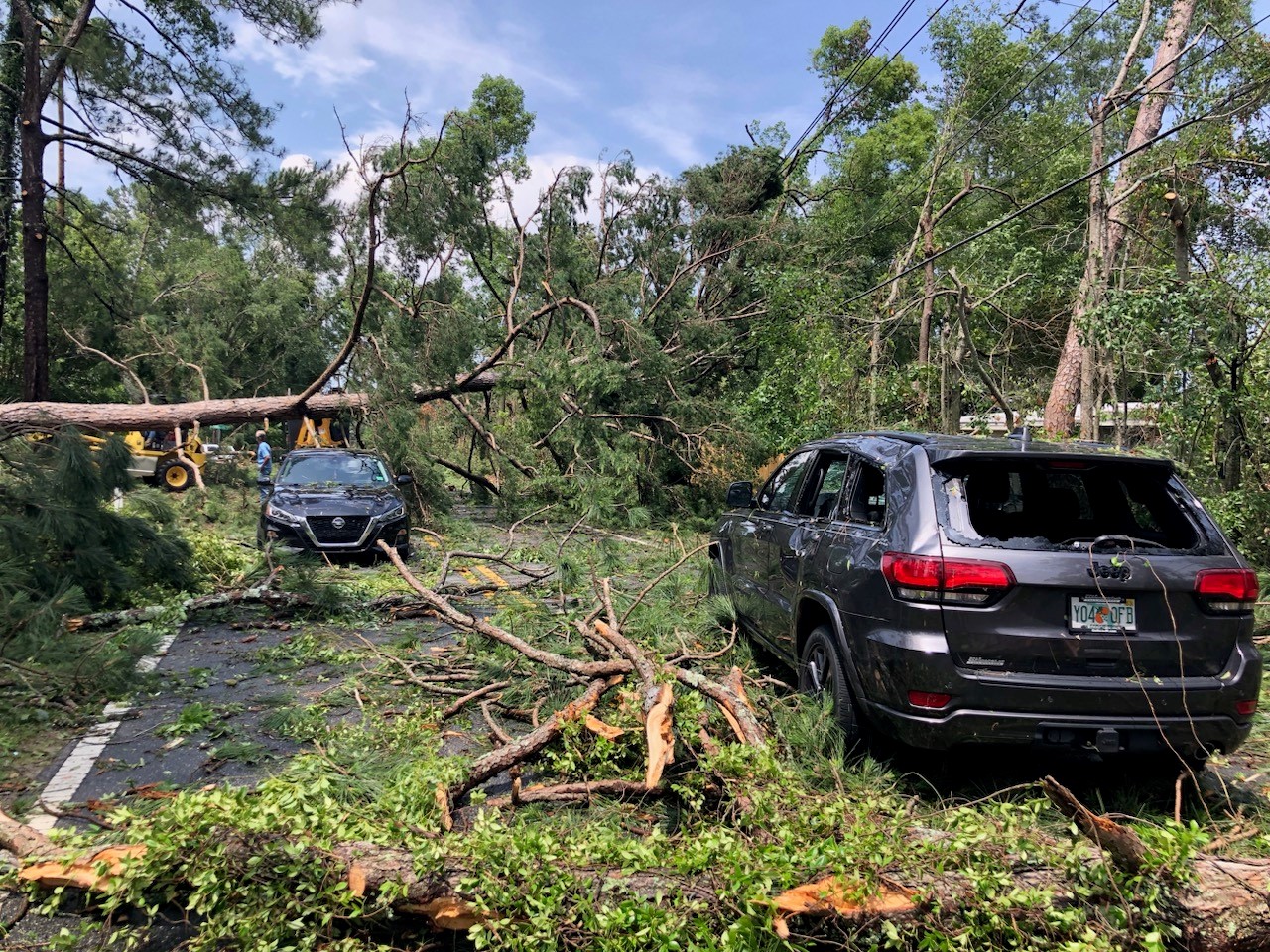What we’re watching: Weekly disaster update, May 13

We know all too well that disaster can strike anytime, anywhere in the world. Some disasters make headlines; others do not. Here at the Center for Disaster Philanthropy (CDP), we monitor the status of disasters worldwide and compile a list of the ones we’re tracking weekly, along with relevant disaster-related media coverage.
Here’s what we’re watching for the week of May 13, 2024.
New or Emerging Disasters
Tornadoes – U.S: Multiple tornadoes spawned from violent storms across the U.S., resulting in casualties and injuries. There were 1,400 severe weather reports and 125 tornado reports across 22 states from May 6 to May 10.
At least three were confirmed dead, two in Tennessee due to an EF-3 tornado, and one in North Carolina.
Michigan saw two EF-2 tornadoes on May 7, resulting in the first tornado emergency to ever be issued in the state.
An EF-3 was also observed in Alabama, where seven people were injured after the tornado struck homes, mobile homes and campers.
At least three tornadoes struck Florida’s capital city including two that converged at the Capital City Country Club, leading to the worst damage in Tallahassee since Hurricane Kate in 2021. Over 45 minutes, the two EF-2 and the one EF-1 tornadoes spun across the city traveling between 20 and 32 miles each. One woman died after a tree fell on her house during the storms. Governor DeSantis expanded a state of emergency to include 15 counties, as more severe weather approached. On Friday night, the city ended its tragic day with a rare glimpse of the northern lights.
April and May are typically the most active months for tornadoes and so far, 2024 has seen tornadoes higher than the historical average.
For more, see our 2024 U.S. Tornadoes disaster profile.
Complex Humanitarian Emergency – Mozambique: On May 10, an attack on the town of Macomia in Cabo Delgado province in Mozambique forced local authorities, civilians and humanitarian workers to flee in the fields and bushes. Humanitarian partners’ warehouses and supplies were looted by armed groups, including 15 vehicles.
In Macomia, more than 156,000 people need humanitarian assistance, including 70,604 internally displaced people and 47,000 returnees. The number of casualties and injuries currently remains unknown, and the number of displacements is expected to increase.
Flooding – Afghanistan: Since May 10, heavy rainfall and flash floods killed at least 180 people and injured 242, according to the most recent update from the United Nations Office for the Coordination of Humanitarian Affairs (UNOCHA). The number of casualties and injuries varies, with the World Food Programme reporting up to 311 fatalities. Search and rescue operations are ongoing, and the number of casualties is expected to rise.
Almost 9,000 homes were damaged or destroyed and roads in Badakhshan, Baghlan and Takhar provinces, the most affected provinces, are rendered inaccessible making assessments and aid distributions more challenging.
This is the largest flooding event in Afghanistan in 2024 so far and comes after an unseasonal rainfall in mid-Aprilwhich killed at least 66 people.
For more, see our Afghanistan Humanitarian Crisis disaster profile.
Flooding – Indonesia: Torrential rain triggered flash floods and cold lava flow from Mount Marapi on Sumatra island, killing at least 41 people, according to a local disaster official. The heavy downpour led to ash and large rockfall. Approximately 400 people, including soldiers, local rescue groups and police were deployed to search for 17 identified missing people. Moderate to heavy rainfall with local thunderstorms is forecasted in the coming days.
Storm – India: A severe 15-minute hailstorm on May 5 left three people dead due to lightning and almost 15,000 properties damaged in the state of Manipur. Some parts of affected districts saw four to five inches of hail and urban cities experienced flooding. Over 28,000 houses and agricultural land suffered extensive damage. The state of Manipur seeks 200 crores ($23.9 million) in relief and designation of the event as a disaster.
Wildfire – Canada: Several wildfires have been affecting Manitoba and British Columbia provinces since May 10, resulting in damages and evacuations. More than 190,200 acres (77,000 hectares) have reportedly burned in British Columbia alone. As of May 13, evacuation orders were active for more than 4,000 people.
Over 145 active wildfires are burning in Canada with almost 40 out of control. The Canadian government has warned of higher temperatures and weather conditions that may create a difficult wildfire season this year.
For more, see our 2024 North American Wildfires disaster profile.
Previous/Ongoing Disasters
Flooding – Brazil: Floods triggered by torrential rain in Brazil’s Rio Grande do Sul state have displaced more than 538,000 people and cut off access to drinking water, food, shelter and electricity for around 800,000 people. According to the International Federation of Red Cross and Red Crescent Societies, as of May 12, 143 people have died, 806 have been injured and 130 are still missing.
The government announced $2.3 billion in emergency spending to tackle the floods, bringing the total federal fund relief to $11.7 billion. A state of calamity was declared for civil protection and humanitarian assistance on May 6.
For more, see our 2024 Rio Grande do Sul Brazil Floods disaster profile.
Flooding – East Africa: Heavy rain and floods have affected nearly 843,773 people across Eastern Africa. In the May 12 flash update by UNOCHA, urgent and critical needs include a multi-sectoral response for food, health care, shelter, water, sanitation and hygiene (WASH) interventions, and essential supplies. This also includes additional funding to scale up responses as heavy rain is forecasted to persist throughout May. In Kenya alone, over 281,000 people were displaced and an estimated 267 people were killed due to the floods.
For more, see our 2024 East Africa Flooding and Cyclone disaster profile.
Drought – Zambia: The extended severe drought in Zambia is now the driest agriculture season in over 40 years and has impacted nearly half the population. Nearly 45% of the country’s maize plants are destroyed, resulting in a projected significant 50% reduction in crop production. The drought also poses an enormous risk to health outcomes for affected communities living with HIV. In response, the United Nations launched a response appeal for $228.3 million, targeting 4.6 million people from May to December 2024.
In addition to the disasters listed above, we are actively monitoring the following disasters or humanitarian emergencies. For more information, see the relevant disaster profiles, which are updated regularly.
In addition to the disasters listed above, we actively monitor the following disasters or humanitarian emergencies. For more information, see the relevant disaster profiles, which are updated regularly.
- Gaza-Israeli Humanitarian Crisis
- Haiti Humanitarian Crisis
- Horn of Africa Hunger Crisis
- Sudan Humanitarian Crisis
- 2024 Taiwan Earthquake
Complex Humanitarian Emergencies – Cameroon
Many places worldwide are experiencing emergencies caused by conflict, climate change, drought, famine, economic challenges and other conditions that combine to create a complex humanitarian emergency (CHE). CDP maintains complete profiles on several CHEs, and what CDP considers Level 1 CHEs are profiled in this weekly blog post and tracked.
Armed conflict and violence, epidemics and climate shocks continue to drive humanitarian needs in Cameroon. The United Nations and its partners recently launched the 2024 Humanitarian Response Plan, which seeks $371 million to assist 2.3 million of the most vulnerable people in the country. This comes after only about a third of the 2023 appeal was funded.
So far in 2024, armed conflict repeatedly continued in the far north while the west saw sporadic gunfire, explosive device attacks and abductions harming socio-economic conditions and driving displacement. In late March, both UNHCR – the UN refugee agency and the World Food Programme raised alarms about how the funding shortfall may lead to cutting food assistance to refugees. This comes after rations were already cut in half, removing basic staples like vegetables and oil from food baskets.
Following the alert, a new analysis by the Integrated Food Security Phase Classification found cases of acute malnutrition among children, pregnant women and new mothers are expected to increase between June and October 2024. The situation is expected to worsen significantly unless humanitarian partners strengthen interventions for the prevention, management and surveillance of diseases.
The 2024 appeal currently stands at just 14% funded with the health cluster receiving just 10% of funding.
Upcoming webinar
June 13: Insurance versus Mother Nature: How does losing insurance options affect disaster philanthropy?

What We’re Reading
- Solar Storm Knocks Out Farmers’ Tractor GPS Systems During Peak Planting Season – 404 Media: The solar storm that brought the aurora lights to large parts of the U.S. also broke critical GPS and precision farming functionality in tractors and agricultural equipment during a critical point of the planting season. The outages highlight how vulnerable modern tractors and the agricultural community are to satellite disruptions, and the potential wide-ranging impact on the food supply system.
- 2024 Atlantic Hurricane Season: Predicting The Economic Impacts – Forbes: Forecasts of an unusually active Atlantic hurricane season for 2024 pose a profound and lasting economic impact, particularly in the insurance markets, building codes, construction and local markets. Proactive preparation and understanding of the associated economic impacts can help mitigate these risks.
- Maui Mayor Takes ‘Bold Step’ To Eliminate 7,000 Short-Term Rentals By 2026 – Honolulu Civil Beats:The elimination of 7,000 short-term rentals will create long-term housing for displaced survivors from the Aug. 8, 2023 wildfires and increase inventory for residents across the county. Eight months after the wildfires, about 3,100 people continue to remain in temporary accommodations.
- Thirsty in paradise: Water crises are a growing problem across the Caribbean islands – The Conversation: The Caribbean is the second most disaster-prone region in the world, facing frequent landslides, devastating hurricanes and destructive storms that do hundreds of millions of dollars in damage. With a weak water infrastructure and water-intensive tourism industry, utilizing rainwater harvesting can increase water supply in the Caribbean and the wider region sustainably.
- Why host country education for refugees isn’t a magical solution – The New Humanitarian: While global education initiatives appear to promote the enrollment of refugees in national education systems in host countries, some important considerations about capacity, accessibility, infrastructure and more, must be prioritized when pursuing such a policy.
Something fun: By now you’ve probably seen at least one picture from this past weekend’s northern lights. See more pictures from the rare solar storm compiled by NPR.
